 |
 |
 |
| |
Fuzeon Improved Maraviroc Response in MOTIVATE and Genotypic Sensitivity Score Matters
|
| |
| |
Efficacy of Maraviroc in Combination with At Least One Other Potent New Antiretroviral Drug: 24-week Combined Analysis of the MOTIVATE 1 and 2 Studies
"....In all treatment groups, undetectable HIV-1 RNA was achieved by a higher proportion of patients who received ENF as part of their OBT when they were naive to ENF.... Patients who received OBT that included first use of a PI experienced a greater virologic response across..." The more drugs a patient was sensitive to the better their viral response was
Reported by Jules Levin
4th IAS, 22-25 July, Sydney, Australia
Elna van der Ryst1, David Cooper2, Irina Konourina1, Mike Saag3, James Goodrich4, Margaret Tawadrous4, Paul Simpson1, John Sullivan1, Mike Westby1 and Howard Mayer4
1Pfizer Global Research and Development, Sandwich, UK
2University of New South Wales, National Centre in HIV Epidemiology and Clinical Research, Sydney, Australia
3University of Alabama at Birmingham, Birmingham, USA
4Pfizer Global Research and Development, New London, USA
AUTHOR CONCLUSIONS
These results demonstrate the additional treatment benefit of including a
potent new drug in a patient's OBT when initiating therapy with maraviroc and
are consistent with data from studies of other recently developed ARVs with
activity against HIV-1 resistant to established agents,10,11 including
raltegravir12,13.
The data on first use of other potent ARVs are consistent with the analysis of
virologic response by GSS, which demonstrates that higher numbers of
patients achieve virologic suppression on maraviroc treatment in subgroups
with more potentially active drugs in their OBT regimen.
In conclusion, these data demonstrate that, in treatment-experienced
patients with CCR5-tropic HIV-1, maraviroc combined with at least one other potent new ARV in the background regimen is highly effective in suppressing HIV-1 RNA over 24 weeks, consistent with an additive effect of maraviroc with other ARVs, as predicted by in vitro data.1
SEE RESULTS BELOW
BACKGROUND
Maraviroc (CELSENTRI) is a highly selective oral CCR5 antagonist that has demonstrated potent activity against R5 viruses resistant to current classes of antiretroviral drugs (ARVs).1-3
In the Phase 3 MOTIVATE studies in treatment-experienced patients with R5
virus, maraviroc plus optimized background therapy (OBT) demonstrated
greater efficacy and a similar safety profile compared with placebo plus OBT
at 24 weeks.4-6
Enfuvirtide (ENF) use as part of OBT was one of the stratification factors
incorporated into the randomization for the two studies. The rationale for this
was to ensure a balance of ENF use between treatment groups, given the
demonstrated efficacy of ENF in this treatment-experienced patient
population.7,8
As shown in Figure 1, both maraviroc treatment groups maintained
superiority over OBT alone, with and without concomitant ENF treatment.
Figure 5. Patients with HIV=1 RNA <50 copies/mL at Week 24
according to Genotypic Susceptibility Score at Baseline 4,5
The more drugs a patient was sensitive to the better their viral response was:
When patients had GSS=0 (genotypically not sensitive to any drugs):
--OBT had 2% <50 c/ml,
--MVC QD+OBT had 28.4% >50 c/ml,
--MVC BID+OBT had 32.7% <50 c/ml.
SENSITIVE TO 1 additional drug, GSS=1:
--OBT had 11% <50 c/ml
--MVC QD+OBT 46.9% <50 c/ml
--MVC bid+OBT 46.7% <50 c/ml
SENSITIVE to 2 additional drugs (GSS=2):
--OBT had 36.6% <50 c/ml
--MVC QD+OBT had 54% <50 c/ml
--MVC bid+OBT had 55.7% <50 c/ml
SENSITIVE TO 3 or more drugs (GSS=3):
--OBT 50.9% <50 c/ml
--MVC qd+OBT 61.7% <50 c/ml
--MVC bid+OBT 59% <50 c/ml
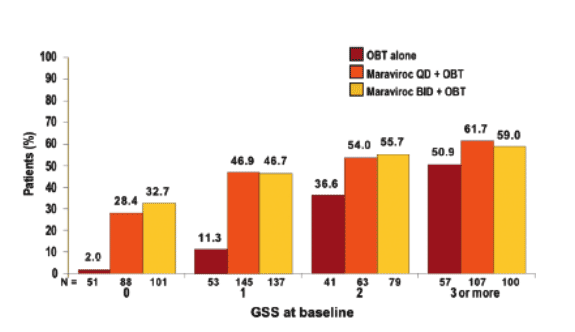
Response by enfuvirtide first use
Thirty-three percent of patients had a history of previous ENF use.
Just over 40% of patients received ENF as part of their OBT.
In all treatment groups, undetectable HIV-1 RNA was achieved by a higher
proportion of patients who received ENF as part of their OBT when they were naive to ENF and had no evidence of resistance to ENF at screening,
compared with patients who had previous experience of ENF or evidence of
resistance.
For both these subgroups of patients, maraviroc treatment groups maintained
superiority over OBT alone (Figure 3).
These findings were consistent across all virologic endpoints analyzed,
including the primary endpoint of HIV-1 RNA reduction from baseline at Week
24 (not shown).
Figure 3. Proportion of patients receiving maraviroc plus OBT
containing enfuvirtide who achieved HIV-1 RNA suppression to
A) <400 copies/mL and B) <50 copies/mL at Week 24 according to first use of enfuvirtide
Fuzeon first use increased percent <400 from 30% taking MVC qd & 49% taking MVC bid to 75%, and percent less than <50 c/ml from 32% to close to 63% taking MVC qd & 53% taking MVC bid among patients with Fuzeon experience/resistance.
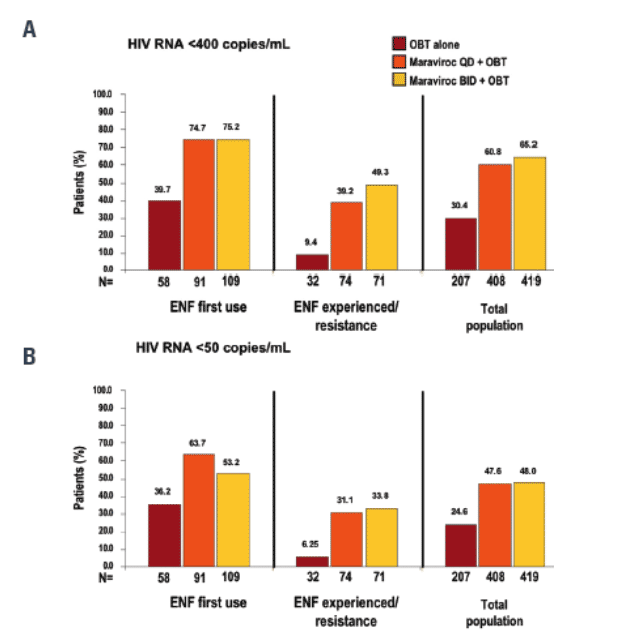
Response by protease inhibitor first use
Patients who received OBT that included first use of a PI experienced a greater virologic response across all endpoints in all three treatment groups, compared with those patients who received the same PI in their OBT but who had a history of prior usage or evidence of resistance to it at screening (Figure 4).
Both maraviroc treatment groups maintained superiority over OBT alone, regardless of the first use of individual protease inhibitors (PIs) in the OBT (i.e. a PI received for the first time in a patient with no evidence of genotypic resistance to that PI at screening) (Figure 4).
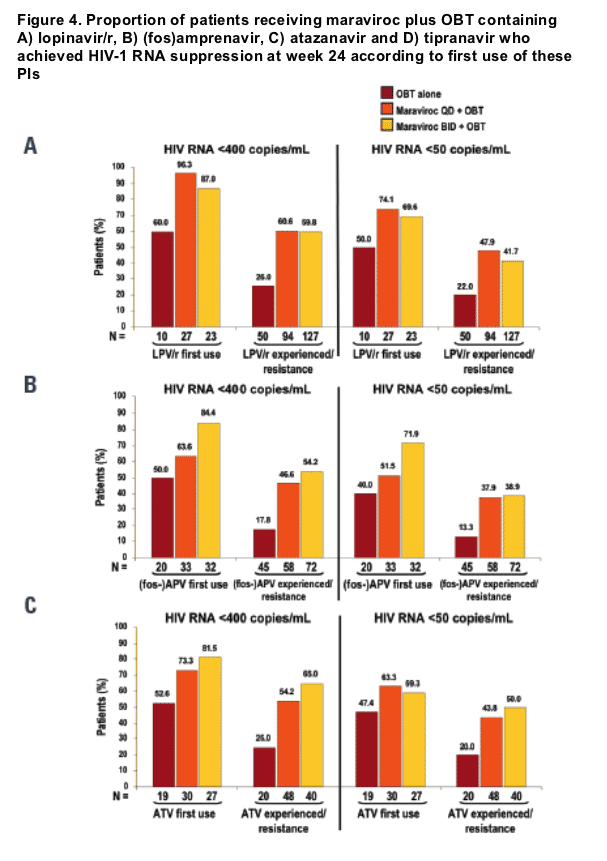
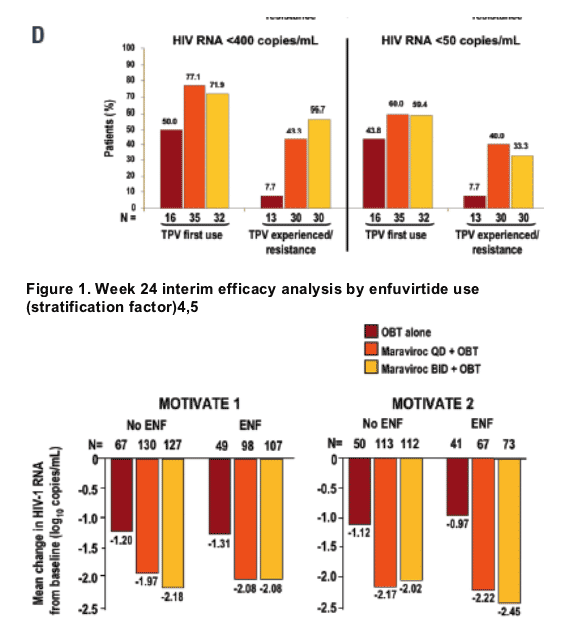
OBJECTIVES
HIV treatment guidelines indicate that adding a drug with a new mechanism
of action and/or a drug with activity against drug-resistant virus to an
optimized background regimen can provide significant antiretroviral activity
in patients with virologic failure due to highly resistant virus.9
The objectives of this analysis were to evaluate the efficacy of maraviroc
when combined with an OBT regimen containing at least one potent ARV
(ENF, lopinavir [LPV], tipranavir [TPV], amprenavir [APV] or atazanavir [ATV])
used for the first time. Darunavir use was not permitted as it was only
available through pre-approval access and no drug-drug interaction data
were available in order to allow co-administration.
METHODS
MOTIVATE 1 (North America) and MOTIVATE 2 (Europe/Australia/USA) are
ongoing, randomized, double-blind, placebo-controlled Phase 3 studies
assessing the safety and efficacy of maraviroc in patients with triple-class
experience and/or resistance and harboring R5 virus.4,5
The study design is summarized in Figure 2.
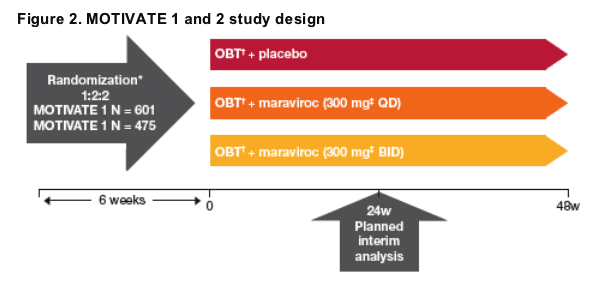
Subgroup analyses at Week 24
Subgroup analyses at Week 24 were carried out on data pooled from the two
MOTIVATE studies, resulting in larger subgroup sizes.
Pooled analysis was justified since the two studies had identical designs, entry criteria, conduct, monitoring and statistical analyses and only minor differences in baseline characteristics for each study population.
Efficacy of maraviroc in combination with an OBT containing ENF, LPV, ATZ,
TPV or APV was assessed on the basis of:
-- first use of the selected OBT drug: patient's usage of the OBT drug was
categorized as 'first use' if the drug history section of the patient's case report form indicated no prior history of the ARV and there was no evidence of drug resistance to the ARV based on the results of the genotypic resistance testing performed at the screening visit. Patients with prior drug history of use or evidence of resistance to it at screening were categorized as 'experienced/resistance'
-- Genotypic Susceptibility Score (GSS): GSS indicates the total number of drugs in the OBT regimen to which a patient's virus isolate showed wildtype
genotypic sensitivity at screening.
The pooled analysis of MOTIVATE 1 and 2 included 1049 patients who received at least one dose of study drug. Demographics and baseline characteristics were well balanced across treatment groups (Table 1).
More than 120 different OBT regimens were used in the two studies. The most
commonly used ARVs are shown in Table 2.
The majority of patients had two or fewer potentially active drugs in their OBT
regimen according to susceptibility testing at screening (Table 1).
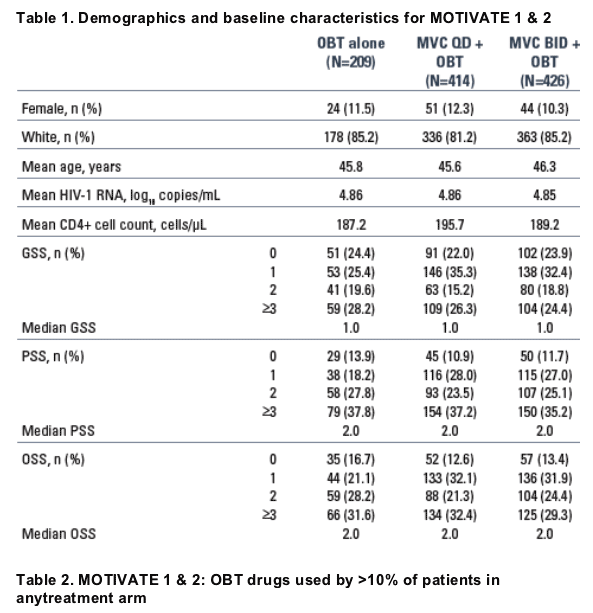
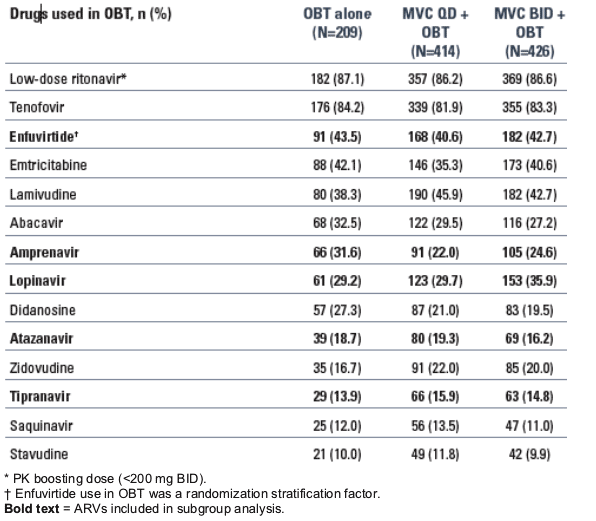
References
1. Dorr P, et al. Antimicrob Agents Chemother 2005; 49:4721-4732.
2. FŠtkenheuer G, et al. Nat Med 2005; 11:1170-1172.
3. Pfizer. Data on file. Presented as part of the FDA Antiviral Drugs Advisory Committee (AVDAC) meeting, held
24 April 2007. Available at: http://www.fda.gov/ohrms/dockets/ac/cder07.htm#AntiviralDrugs. 2007.
4. Lalezari J, et al. 14th Conference on Retroviruses and Opportunistic Infections. Los Angeles, USA, 25-28 February 2007; Abstract 104bLB.
5. Nelson M, et al. 14th Conference on Retroviruses and Opportunistic Infections. Los Angeles, USA, 25-28 February 2007; Abstract 104aLB.
6. Gulick RM, et al. 4th IAS Conference on HIV Pathogenesis, Treatment and Prevention. Sydney, Australia, 22-25 July 2007; Abstract WEPEB116LB.
7. Lalezari JP, et al. N Engl J Med 2003; 348:2175-2185.
8. Lazzarin A, et al. N Engl J Med 2003; 348:2186-2195.
9. Department of Health and Human Services (DHHS). Guidelines for the use of antiretroviral agents in HIV-1-infected adults and adolescents. 2006. Available at: http://aidsinfo.nih.gov/guidelines (accessed June 2007).
10. Cahn P, et al. Clin Infect Dis 2006; 43:1347-1356.
11. Katlama C, et al. AIDS 2007; 21:395-402.
12. Cooper D, et al. 14th Conference on Retroviruses and Opportunistic Infections. Los Angeles, USA, 25-28 February 2007; Abstract 105aLB.
13. Steigbigel R, et al. 14th Conference on Retroviruses and Opportunistic Infections. Los Angeles, USA, 25-28 February 2007; Abstract 105bLB.
|
| |
|
 |
 |
|
|